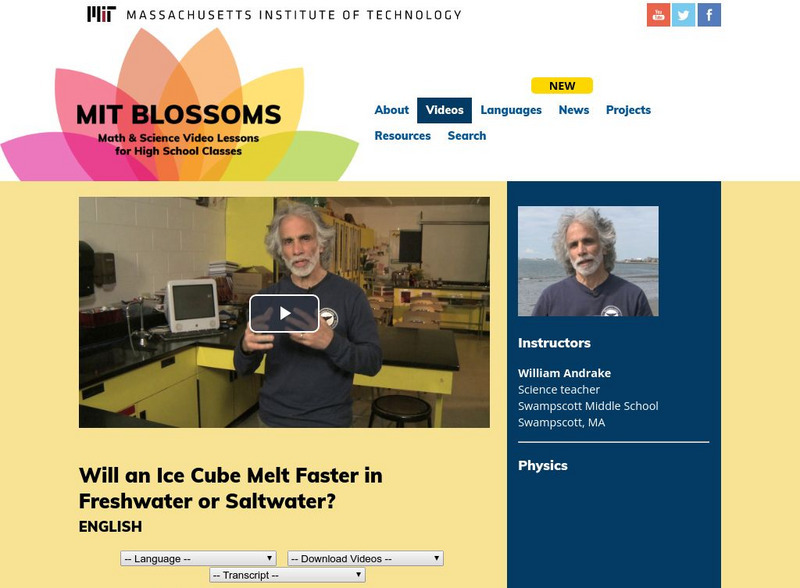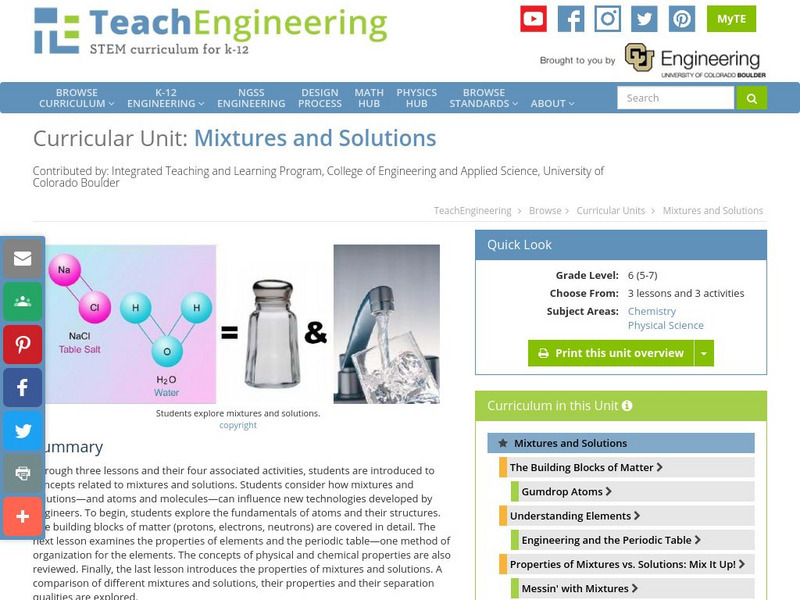Hi, what do you want to do?
CK-12 Foundation
Ck 12: Physics Simulation: Electric Analogies
[Free Registration/Login Required] Explore a different way of thinking about electricity as a way to become familiar with the concept of potential, current, and resistance using this interactive simulation. A PDF worksheet and a video...
TeachEngineering
Teach Engineering: All Fat Is Not Created Equally!
Students learn that fats found in the foods we eat are not all the same; they discover that physical properties of materials are related to their chemical structures. Provided with several samples of commonly used fats with different...
PBS
Pbs Building Big: The Labs
An interactive series of labs describing some basic principles of Physics. The labs demonstrate different basic concepts of physics used in building and creating large structures such as bridges, domes, skyscrapers, dams, and tunnels.
TeachEngineering
Teach Engineering: Quantum Dots and Colors
Students are introduced to the physical concept of the colors of rainbows as light energy in the form of waves with distinct wavelengths, but in a different manner than traditional kaleidoscopes. Looking at different quantum dot...
Massachusetts Institute of Technology
Mit: Blossoms: Will an Ice Cube Melt Faster in Freshwater or Saltwater?
Engage learners in the study of the ocean and saltwater with these activities. Students will see that saltwater has different physical properties than freshwater - mainly density. This lesson can serve as a springboard into other...
TeachEngineering
Teach Engineering: Mixtures and Solutions
This unit covers introductory concepts of mixtures and solutions. Students think about how mixtures and solutions, and atoms and molecules can influence new technologies developed by engineers. The first lesson explores the fundamentals...
NASA
Nasa: Aerial Photography: The Adventures of Amelia the Pigeon
An animated adventure story, developed by NASA, that helps children understand earth science concepts by using satellite photography and other types of aerial photographs to identify physical features on the surface of the earth. Teaches...
Texas Education Agency
Texas Gateway: Kinematics in Two Dimensions: Conceptual Questions
This is a list of 21 questions focusing on the major concepts of each section of Chapter 3: Kinematics in Two Dimensions such as adding and subtracting vectors using different methods.
Symmetry Magazine
Symmetry Magazine: Explain It in 60 Seconds: W Boson
The W boson, described here, is important in the study of the differences between matter and antimatter. "Explain It In 60 Seconds" is an article series that aims to summarize in a few paragraphs the meaning of different concepts in...
Symmetry Magazine
Symmetry Magazine: Explain It in 60 Seconds: Acceleration of Particles
The process of particle acceleration is described. "Explain It In 60 Seconds" is an article series that aims to summarize in a few paragraphs the meaning of different concepts in particle physics.
Symmetry Magazine
Symmetry Magazine: Explain It in 60 Seconds: Dark Matter
Dark matter is still quite a mystery to scientists, who hope to learn more about it through experiments with particle accelerators. "Explain It In 60 Seconds" is an article series that aims to summarize in a few paragraphs the meaning of...
Symmetry Magazine
Symmetry Magazine: Explain It in 60 Seconds: Jets
Jets, described in this article, are particle sprays resulting from other particles colliding at high speeds, such as can happen in particle accelerators. "Explain It In 60 Seconds" is an article series that aims to summarize in a few...
Symmetry Magazine
Symmetry Magazine: Explain It in 60 Seconds: Rare Particle Decays
Rare particle decays, described here, are events that could lead to insights into the unknown processes of the universe. Scientists hope to learn more about them through research with particle accelerators. "Explain It In 60 Seconds" is...
Symmetry Magazine
Symmetry Magazine: Explain It in 60 Seconds: Virtual Particles
Virtual particles, described here, are particles that appear and disappear so rapidly they can be detected only by their effect on other particles. "Explain It In 60 Seconds" is an article series that aims to summarize in a few...
Symmetry Magazine
Symmetry Magazine: Explain It in 60 Seconds: Neutralinos
Neutralinos, described here, are hypothesized particles of dark matter. Scientists hope to confirm their existence through their research with the Large Hadron Collider. "Explain It In 60 Seconds" is an article series that aims to...
Symmetry Magazine
Symmetry Magazine: Explain It in 60 Seconds: The International Linear Collider
The International Linear Collider, when built, will be larger than the Large Hadron Collider near Geneva. A short description is given here. "Explain It In 60 Seconds" is an article series that aims to summarize in a few paragraphs the...
Symmetry Magazine
Symmetry Magazine: Explain It in 60 Seconds: Luminosity
Luminosity, described here, is a scale for measuring how efficiently a collider works. "Explain It In 60 Seconds" is an article series that aims to summarize in a few paragraphs the meaning of different concepts in particle physics.
Symmetry Magazine
Symmetry Magazine: Explain It in 60 Seconds: Quarks
Quarks, described here, are particles of matter that cannot be further broken down. Thus they are called fundamental particles. "Explain It In 60 Seconds" is an article series that aims to summarize in a few paragraphs the meaning of...
Symmetry Magazine
Symmetry Magazine: Explain It in 60 Seconds: The Standard Model
The Standard Model is the theory scientists use to understand how the universe is constructed. They recognize that it has deficiencies as not everything they observe can be explained with it. "Explain It In 60 Seconds" is an article...
Symmetry Magazine
Symmetry Magazine: Explain It in 60 Seconds: The Higgs Boson
The Higgs boson, a particle hypothesized by Peter Higgs, is described in this article. "Explain It In 60 Seconds" is an article series that aims to summarize in a few paragraphs the meaning of different concepts in particle physics.
Symmetry Magazine
Symmetry Magazine: Explain It in 60 Seconds: Simulations
Simulations are useful research tools for scientists and save a lot of time and money. Some of the ways they are used are described in this article. "Explain It In 60 Seconds" is an article series that aims to summarize in a few...
Symmetry Magazine
Symmetry Magazine: Explain It in 60 Seconds: String Theory
String Theory, a theory about how the universe works, is explained briefly here. "Explain It In 60 Seconds" is an article series that aims to summarize in a few paragraphs the meaning of different concepts in particle physics.
Symmetry Magazine
Symmetry Magazine: Explain It in 60 Seconds: Particle Event
Particle events, described in this article, are events that can be observed with a particle detector. "Explain It In 60 Seconds" is an article series that aims to summarize in a few paragraphs the meaning of different concepts in...
Symmetry Magazine
Symmetry Magazine: Explain It in 60 Seconds: Dark Energy
Dark energy, described here, is the ultimate mystery for scientists. It is the force that is causing the expansion of the universe they believe. "Explain It In 60 Seconds" is an article series that aims to summarize in a few paragraphs...











